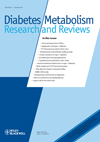Effects of Nordic walking on cardiovascular risk factors in overweight individuals with type 2 diabetes, impaired or normal glucose tolerance
Abstract
Background
Physical activity remains a valuable prevention for metabolic disease. The effects of Nordic walking on cardiovascular risk factors were determined in overweight individuals with normal or disturbed glucose regulation.
Methods
We included 213 individuals, aged 60 ± 5.3 years and with body mass index (BMI) of 30.2 ± 3.8 kg/m2; of these, 128 had normal glucose tolerance (NGT), 35 had impaired glucose tolerance (IGT) and 50 had type 2 diabetes mellitus (T2DM). Participants were randomized to unaltered physical activity or to 5 h per week of Nordic walking with poles, for a 4-month period. Dietary habits were unaltered. BMI, waist circumference, blood pressure, glucose tolerance, clinical chemistry, maximal oxygen uptake (peak VO2) and self-reported physical activity (questionnaire) were assessed at the time of inclusion and after 4 months. The participants in the exercise-intervention group kept a walking diary.
Results
In the NGT exercise group, self-reported physical activity increased markedly, and body weight (−2.0 ± 3.8 kg), BMI (−0.8 ± 1.4 kg/m2) and waist circumference (−4.9 ± 4.4 cm) (mean ± SD) decreased. Exercise power output (12.9 ± 9.9 W) and peak VO2 (2.7 ± 2.8 mL/kg/min) increased in the IGT exercise group. More cardiovascular risk factors were improved after exercise intervention in people with NGT compared with those with IGT or T2DM. Exercise capacity improved significantly in all three groups of participants who reported at least 80% compliance with the scheduled exercise.
Conclusions
Nordic walking improved anthropometric measurements and exercise capacity. However, unsupervised Nordic walking may not provide a sufficient increase in exercise intensity to achieve ultimate health-promoting benefits on the cardiovascular parameters assessed in this study, particularly for those with disturbed glucose regulation. Copyright © 2012 John Wiley & Sons, Ltd.




